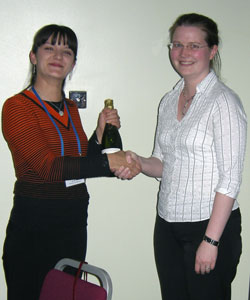Mustapha is a Senior Research Associate in the group and is a highly experienced and efficient programmer. His specialism is C++ and he is responsible for the Small Molecule ToolKit, SMTK.
Acta Cryst. (2011), A67, 21-34. Â Â [ doi:10.1107/S010876731004287X ]
The practical use of the average and difference intensities of Friedel opposites at different stages of structure analysis has been investigated. It is shown how these values may be properly and practically used at the stage of space-group determination. At the stage of least-squares refinement, it is shown that increasing the weight of the difference intensities does not improve their fit to the model. The correct form of the coefficients for a difference electron-density calculation is given. In the process of structure validation, it is further shown that plots of the observed and model difference intensities provide an objective method to evaluate the fit of the data to the model and to reveal insufficiencies in the intensity measurements. As a further tool for the validation of structure determinations, the use of the Patterson functions of the average and difference intensities has been investigated and their clear advantage demonstrated.
Electronic reprints
Publisher’s copy
J. Appl. Cryst. (2011), 44, 52-59.   [ doi:10.1107/S0021889810042470 ]
One of the requirements for the next generation of small-molecule crystallographers is a mathematical programming infrastructure. It should provide a modelling design process, where the model formulation is kept separate from the optimization process to provide gains in reliability, scalability and extensibility, enabling the application of optimization components in general, and refinement-based applications in particular, as applied to crystallographic problems. A research project has been undertaken to design and implement an innovative toolkit library – a small-molecule toolkit (SMTK) – for crystallographic modelling and refinement. This paper provides an overview of SMTK and its object-oriented implementation. As a practical illustration, it also shows the context of use for a set of classes and discusses how the toolkit enables the user rapidly to develop, maintain and explore the full capabilities of crystallography and so create new applications. SMTK reduces the degree of effort required to construct and develop new algorithms and provides users with an easy and efficient means to test ideas, as well as to build large and maintainable models which can readily be adapted to any new situation.
Publishers copy:
The final dinner of the British Crystallographic Association Spring Meeting in Warwick was interrupted, as always, with the prize winning awards. Amber Thompson was awarded the International Union of Crystallography Prize (a copy of International Tables) for her explanation of the advantages of choosing non-standard space groups. Kirsten Christensen was awarded the Durward Cruickshank prize for a young crystallographer who had made an outstanding contribution to crystallography.
Other contributions include:
N. David Brown, James Haestier, Mustapha Sadki, Amber L. Thompson & David J. Watkin
matchbOx:Â Automatic Structure Matching to Facilitate Crystallographic Refinement (YC Presentation)
Kirsten E. Christensen, Christopher J. Serpell, Nicholas E. Evans & Paul D. Beer
Pushing the Boundaries of Small Molecule Crystallography:Â The Challenging Structure of a Macrocyclic Anion Sensor (Poster)
Richard I. Cooper, Amber L. Thompson & David J. Watkin
The Hydrogen Challenge:Â Where are we Now? (Poster)
Christopher J. Serpell & Paul D. Beer
Refinement of Large Supramolecular Structures (Presentation)
David J. Watkin
Dealing with Difficult Data (Session Chair)
The 25th European Crystallographic Meeting was held in the Harbiye Museum and Cultural Centre in the beautiful city of Istanbul. It was a very eventful week, and contributions to the conference made by Chem. Cryst. include:
N. David Brown, James Haestier, Mustapha Sadki, Amber L. Thompson & David J. Watkin
A Further Improved Structure Matching Algorithm (Poster)
James Haestier
Handling of Cell Errors and their Effect on Derived Parameters (Poster)
Mustapha Sadki
New Modelling for Disordered Atoms in Free-form Based Hybrid Refinement and Visual Representation (Poster)
Mustapha Sadki
The Application of Novel Modelling and Refinement Strategies to Crystallography (Presentation)
Amber L. Thompson & David J. Watkin
Absolute Configuration Determination – Is there More Information in the Data? (Poster)
David J. Watkin, Richard I. Cooper & Amber L. Thompson
CRYSTALS:Â Refinement and Validation Tools (Poster)
David Watkin
The Future of Small Molecule Software (Session Chair)
The 2009 British Crystallographic Association Spring Meeting was held at the University of Loughborough. Contributions from Chem. Cryst. included:
N. David Brown, James Haestier, Mustapha Sadki, David J. Watkin & Amber L. Thompson
A Further Improved Structure Matching Algorithm (Poster)
James Haestier
Effects of Cell Errors on Derived Parameters (YC Presentation)
James Haestier
Computation of Cell Errors Effects on Derived Parameters (Poster)
Mustapha Sadki & David J. Watkin
New Framework for Reliable Refinement Data Types (Presentation)
The Annual Meeting of the British Crystallography Association was held in York. Contributions from Chem. Cryst. included:
Anna Collins, Richard I. Cooper, Andrew R. Cowley, David J. Watkin
2-(1-Hydroxy-2-methyl-propyl)-2,5-dihydro-furan-2-carboxylic acid diisopropylamide: A study of a phase transition to a pseudosymmetrical Z′=2 structure (Poster)
James Haestier, Mustapha. Sadki, Amber L. Thompson and David J. Watkin
Cell Parameter Standard Uncertainties and their Effect on Crystallographic Data (Poster)
Mustapha Sadki, James Haestier, Amber L. Thompson & David J. Watkin
Computational Infrastructure for Bridging the Gap between Previous and Future Generations of Crystallographers (Poster)
